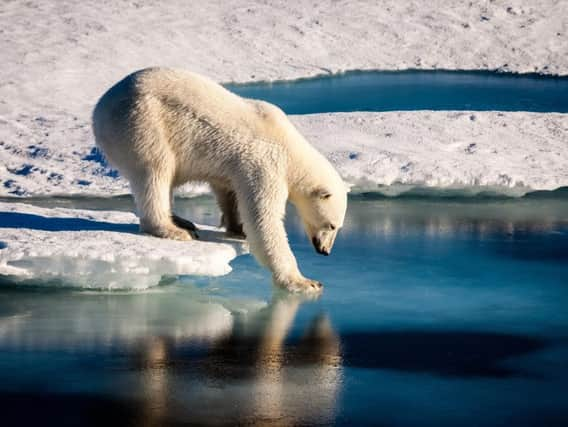Polar bear footprints yield DNA evidence of how far they travel due to climate change


The Arctic is “ground zero” for climate change with polar bears on the front line.
Rod Downie, chief polar adviser at the environmental campaign group WWF, who has had many face-to-face encounters with polar bears in over two decades working in remote Arctic regions, said: “It is remarkable what you can tell from a footprint in the snow.
Advertisement
Hide AdAdvertisement
Hide Ad“Samples of snow from a polar bear’s huge footprint were sent off to Spygen biotechnology company at the University of Grenoble in France and the results were amazing.
“Scientists picked up genetic markers of three different species. They could tell that when the samples were taken the polar bear had been feeding on a seal and that a gull had flown down.”
That information gave scientists a good indication of how far the polar bear had travelled, possibly due to shrinking sea ice.
There are estimated to be only around 20,000-31,000 of the animals left in the wild.
Mr Downie, who grew up in Drummore on the Mull of Galloway, in Dumfries and Galloway, will be giving a series of public lectures about the danger and excitement of meeting polar bears in the wild and what can be done to protect them in a time of climate change.
The ‘Icons on Ice: Innovation in Polar Bear Conservation’ - for the Royal Scottish Geographical Society’s (RSGS) Inspiring People s talks will be held in Dumfries on 27 January, Galashiels 28 January, Ayr 29 January and Helensburgh on 30 January.
Mr Downie’s work has included taking a “polar bear census” with the Government of Nunavut in the Canadian Arctic because more accurate data is needed to help conserve the species.
“I am in absolute awe of these animals.... The first time I saw one it was less than 100 metres away. I was thinking ‘ that polar bear has 42 razor-sharp teeth is 7-8 times my body weight and could cover the distance between us faster that Usain Bolt.” - Rob Downie, chief polar adviser at WWF.
Advertisement
Hide AdAdvertisement
Hide AdThis involved Mr Downie and team members undertaking darting operations - flying a helicopter down low after spotting a polar bear, firing a biopsy dart into a polar bear’s haunch and Mr Downie jumping out to collect the dart which contains hair skin and fat for analysis.
“I am in absolute awe of these animals.... The first time I saw one it was less than 100 metres away. I was thinking ‘ that polar bear has 42 razor-sharp teeth is 7-8 times my body weight and could cover the distance between us faster that Usain Bolt.”
A less dangerous method involves using a low-flying aircraft and state-of-the-art infra red photography to create a ‘polar bear census.’
Mr Downie, who previously worked for the British Antarctic Survey, said: “Polar bears are facing a range of threats such as melting sea-ice and humans moving into their parts of their territory. But we’re also looking at ways of minimising the impact of oil, gas and shipping on them.”
Mike Robinson, chief executive of the RSGS, said: “In spite of the threats posed to the arctic by global increases in temperature, Rod Downie and the WWF are working hard to promote a sustainable future for polar bears in the wild.
“I hope that these talks will inspire those in attendance to learn more about these incredible animals and encourage them to think more broadly about how we can preserve their habitat for generations to come.”
* Tickets for ‘Icons on Ice’ available at door or online via Eventbrite. Tickets £10, free for RSGS members, students and U18s.
The Young Geographer Magazine and the Arctic
The Royal Scottish Geographical Society’s publication - ‘The Young Geographer magazine, written for young people for young people, December edition, is focussing on the Arctic.
Advertisement
Hide AdAdvertisement
Hide AdIt features an interview with Swedish climate change campaigner Greta Thunberg, an article by Holly Gillibrand, a 14-year-old environmentalist and school striker from Lochaber High school in Fort William and a piece with Arctic endurance swimmer and oceans campaigner Lewis Pugh.